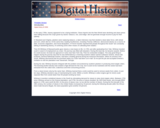
Short descriptions of important technological innovations produced in America and the date of their introduction.
- Subject:
- Social Studies
- Material Type:
- Reading
- Provider:
- PBS
- Provider Set:
- American Experience
- Date Added:
- 08/28/2023

Short descriptions of important technological innovations produced in America and the date of their introduction.

A brief look at how slavery in America was tied to the crops grown in the South. See how the need for skilled workers was decreased and the use of unskilled slaves increased with the introduction of the cotton gin.

A comprehensive look at the economy of the South and the changes brought by the cotton gin. Read through five pages that discuss the economy, the tradition of the plantation, and the sectionalism that arises in this time period.

Video looks at the history of slavery in America including how it started, the impact that the invention of the cotton gin had on slavery, abolition, the slavery debate as the nation expanded westward, the Civil War, and the aftermath of the slavery system. [3:01]

Read about Eli Whitney's cotton gin and its importance to the cotton industry.

Interactive image of Eli Whitney's plans for the cotton gin, accompanied by an explanation of the cotton gin's purpose and significance in relation to the Industrial Revolution.

This site provides information on American inventors Benjamin Franklin, Robert Fulton, Eli Whitney, Thomas Jefferson, Isaac Singer, Wilbur Wright, Thomas Alva Edison, Elias Howe, and Alexander Graham Bell. It offers pictures from and links to exhibits in the various Smithsonian museums in Washington, D.C.

A brief video that describes the unintended consequence of Eli Whitney's cotton gin. [5:14] Followed by a quiz and a list of additional resources to explore.

This National Archives and Records Administration site relates the history of Eli Whitney and his remarkable inventions. Links to sites with patent information on the cotton gin. Tons of teacher's resources can be found at this site.

U.S. History is designed to meet the scope and sequence requirements of most introductory courses. The text provides a balanced approach to U.S. history, considering the people, events, and ideas that have shaped the United States from both the top down (politics, economics, diplomacy) and bottom up (eyewitness accounts, lived experience). U.S. History covers key forces that form the American experience, with particular attention to issues of race, class, and gender.Senior Contributing AuthorsP. Scott Corbett, Ventura CollegeVolker Janssen, California State University, FullertonJohn M. Lund, Keene State CollegeTodd Pfannestiel, Clarion UniversityPaul Vickery, Oral Roberts UniversitySylvie Waskiewicz

The Market Revolution of the early nineteenth century changed the way Americans worked and did business. In this video, Kim discusses the inventions that brought new productivity and forms of work to American business - the Industrial Revolution. [11:30]
Khan Academy learning modules include a Community space where users can ask questions and seek help from community members. Educators should consult with their Technology administrators to determine the use of Khan Academy learning modules in their classroom. Please review materials from external sites before sharing with students.


By the end of this section, you will be able to:
Explain the labor-intensive processes of cotton production
Describe the importance of cotton to the Atlantic and American antebellum economy